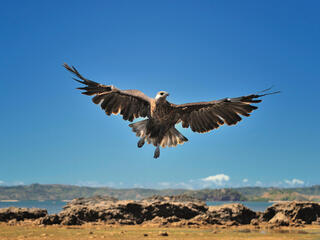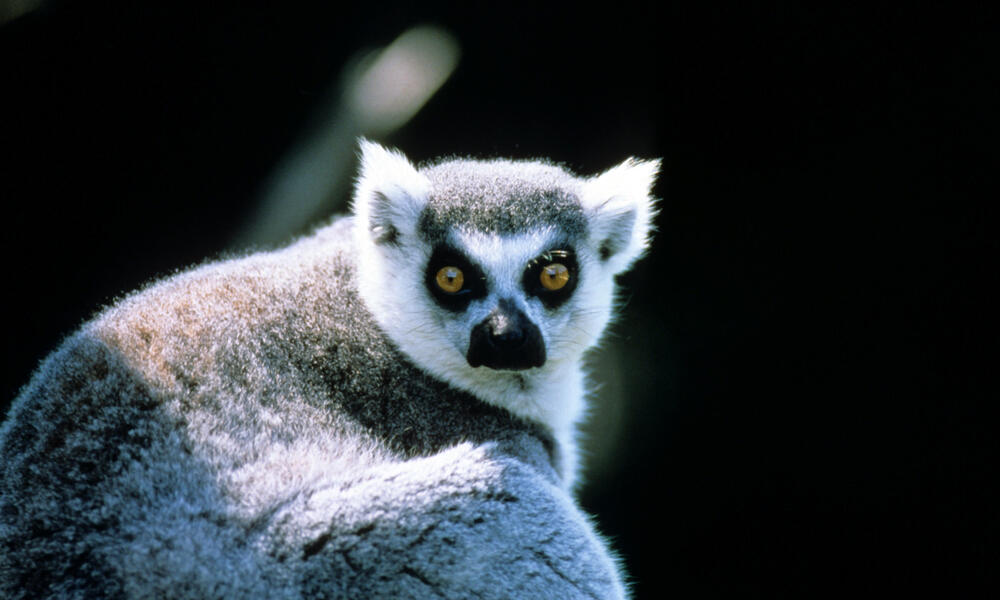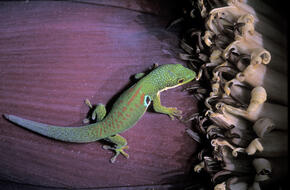Who Are Helping To Protect Malagasy Animals
Republic of madagascar
Facts
The island nation of Republic of madagascar has developed its own distinct ecosystems and extraordinary wildlife since information technology split from the African continent an estimated 160 meg years ago. Approximately 95 percent of Madagascar'due south reptiles, 89 pct of its plant life, and 92 percent of its mammals exist nowhere else on Earth.
- Continent
Africa
- Species
Lemur, Tortoise, Gecko, Chameleon
Located off the eastward coast of Africa, Madagascar is the world'due south fifth largest isle; at 144 1000000 acres, it's well-nigh the size of Texas. Republic of madagascar's climate is tropical forth the coast, temperate inland, and barren in the south. The island harbors lush rain forests, tropical dry forests, plateaus and deserts. Its more than 3,000 miles of coastline and over 250 islands are dwelling to some of the earth's largest coral reef systems and well-nigh extensive mangrove areas in the Western Indian Ocean.

Species

A dizzying range of plants and animals make their home on the island. More than than 11,000 endemic plant species, including seven species of baobab tree, share the isle with a vast diverseness of mammal, reptiles, amphibians, and others. From 1999 to 2010, scientists discovered 615 new species in Madagascar, including 41 mammals and 61 reptiles.
Madagascar has several critically threatened species including the Silky Sifaka, a lemur, which is one of the rarest mammals on earth. Its proper name—"angel of the forest"—refers to its white fur. Some other threatened species, the rare Ploughshare tortoise, is found but in a minor area of northwestern Madagascar where as few as 1,000 of these animals survive. Ploughshare tortoises can be sold illegally for upward to $200,000 on exotic pet markets.
People & Communities

Vanilla farmers in Madagascar.
The variety of the island is seen everywhere. Madagascar is dwelling house to more than than 21 million people with a broad array of faiths and customs. The Malagasy (equally the people of Madagascar are known) are descendents of settlers from Borneo and East Africa and draw their cultural heritage from Southeast Asia, India, Africa, and the Middle East.
More than 20 indigenous groups coexist on the isle. Their common language, besides called Malagasy, is nearly closely related to a language spoken in southeast Borneo. A majority of the population—80 percent of which is estimated to live below the poverty line—depends on subsistence farming for survival.
Threats

Republic of madagascar'southward stunning species and unique habitats are threatened by demands from today's global markets and from the growing needs of the local population.
Deforestation and Woods Degradation
The small-scale but widespread clearance of forests, primarily for firewood and charcoal product, is jeopardizing the island'south habitats. Equally a result, several charismatic species such as lemurs and chameleons that evolved here over millions of years may become extinct earlier the end of the century.
Illegal Wildlife Trade

For the unique species of the island, loss of vital habitat is a disaster and the increased access to species has likewise exacerbated the international trade in Madagascar's wildlife. Today, many animals and plants are threatened, with rosewood trees, tortoises, chameleons, geckos and snakes the most targeted by traffickers.
What WWF Is Doing

WWF aims to protect, restore and maintain Madagascar'south unique biodiversity in harmony with the civilisation and livelihoods of the local people. Nosotros work closely with governments, scientists, industry and local communities on several areas that present the best opportunities to secure the future for the isle's people and species.
Protecting the Dry and Spiny Forests
WWF has adult a programme to address firsthand threats to Republic of madagascar's southernmost forests and aid local communities manage their natural resources more than sustainably.
Sustaining Livelihoods of Coastal Communities
WWF works with traditional fishermen and government authorities to manage marine and littoral resources and so that they not only contribute to conservation but also benefit local communities.
Adapting to Climate change
WWF helps decision makers, technical officers, and local regime to develop and implement responsive strategies to protect local communities and natural ecosystems from the expected impacts of climate alter.
Experts
-
 Rachel Kramer Deputy Chief of Political party, Targeting Natural Resources Corruption
Rachel Kramer Deputy Chief of Political party, Targeting Natural Resources Corruption
How You lot Can Help
Source: https://www.worldwildlife.org/places/madagascar
Posted by: binfordalthatede.blogspot.com


0 Response to "Who Are Helping To Protect Malagasy Animals"
Post a Comment